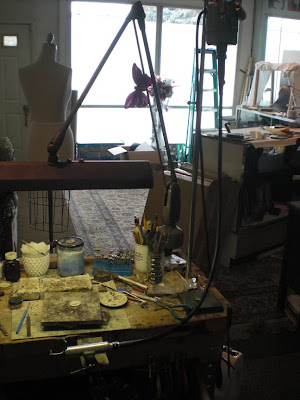
It seems appropriate to start the studio tour in the place where I spend most of my time. Right here looking at this workbench. It is a double wide workbench, made for two people to sit side by side, but I have arranged to use the whole space for my efficiency. On the left I keep a crockpot of acid called "pickle" for cleaning the metal after soldering operations. The acid is then neutralized by a bath of baking soda water before work continues.
In the center is a Hoke brand oxy/propane fueled torch on a home-made hanger-- it is a good idea to have a place to hang your torch so that it does not have to be turned off every time you need to use both of your hands. Be certain that the hanger is tall enough and far enough away from any objects that could catch fire
The following image is of the main part of my workbench. It is arranged so that while working, as many tools as possible are within an arm's reach.

A: a measuring tape for sewing can be stapled across the front edge of your catch tray for quick measurements, and you always know where it is! (unlike some of my other rulers)
B: sharpstone- I keep a sharpstone on hand for shaping rubber wheels to fit in tight places and to keep gravers sharp
C: plate for spare parts- a small container (or tea saucer) It is helpful to keep track of your scraps so that nothing goes to waste. I to sweep most scraps to the upper right hand corner of the catch- tray, but the small parts like an extra jump ring or spare ear-wire are kept in the plate waiting to be used
D: bur collection-it takes a while to build a good variety-- I started with a small assorted shapes set, but found that most often, I needed a very particular size of each shape, so I have bought a set of graduated sizes in each of the following shapes: cylinder, setting, hart, bud, round, cup.
E: super glue aka cyanoacrylate I keep some of this handy for sealing bad cuts-- not necessarily medically advised, but on a clean cut, it stops the bleeding immediately and allows me to keep working after taping up the injury.
F: white out- works like yellow ochre to protect a solder seam from re-flowing while heating another part of the piece. The fumes are not good to breathe in...use only with proper ventilation and/or a respirator.
G: gluestick: use a gluestick or rubber cement to adhere a drawing to a sheet of metal for accuracy while sawing.
H: flux-to keep your large container of flux from getting dirty, transfer a small amount into a smaller container for on the workbench. It takes up less space too.
I: water jar for quenching hot metal
J: rubber wheels/sanding discs/brushes for flex shaft machine
K: pencils, sharpies and tinsnips
L:needle files and scribe
M: this is an assortment of fingertip protectors. They are made from leather and masking tape, and protect the finger most likely to be injured during a specific task.
N: steel bench block.
O:tweezers and solder picks,
P: Firebrick: a few different sizes and types of solder bricks help for proper set-up of the item to be soldered.
Q: put down a spare linoleum tile to avoid burning your bench if the heat makes it the whole way through the fire brick
R: Benchpin- you can use coarse files to alter your benchpin.. It may be helpful to file a notch in one end for working with tiny parts, or drill a hole the whole way through to work on the front of earrings with posts (good luck remembering which hole goes the whole way through!)
 Another method for keeping more of your tools right by your side while working is to make home-made attachments and hangers. A nail driven halfway into the side of your bench is perfect for hanging your sawframe, and a home-made or even store bought drawer pull placed low on the bench drawer will hang all of your pliers nicely in a row. Part of the convenience of these specialty hangers is that it helps you keep track of your tools. You'll spend less time looking for that one pair of pliers if you know that they are always in the same place.
Another method for keeping more of your tools right by your side while working is to make home-made attachments and hangers. A nail driven halfway into the side of your bench is perfect for hanging your sawframe, and a home-made or even store bought drawer pull placed low on the bench drawer will hang all of your pliers nicely in a row. Part of the convenience of these specialty hangers is that it helps you keep track of your tools. You'll spend less time looking for that one pair of pliers if you know that they are always in the same place.






